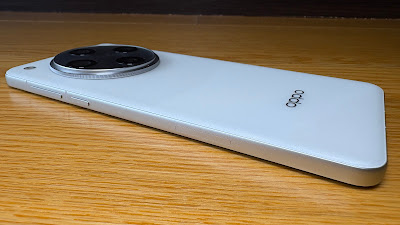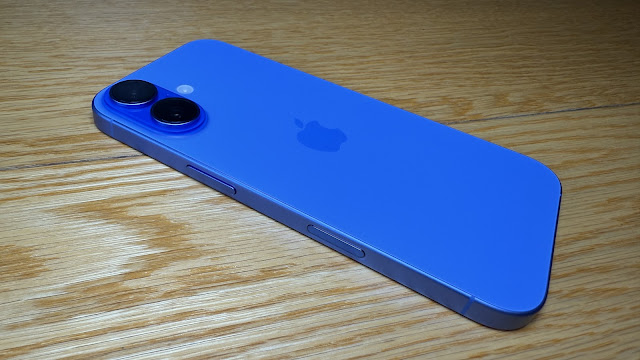I still remember trying an Oppo phone for the first time.
I'd never really heard of the brand up until then so I was blown away when I discovered how good the phone was, especially the camera.
The first periscope lens I experienced on a phone was on an Oppo phone.
The first time I used a popup camera on a phone was on an Oppo phone.
The first time I saw truly fast charging was with an Oppo phone.
So it was no surprise the first time I encountered four 50MP lenses on one handset was also on an Oppo phone.
The Oppo Find X8 Pro is like a supercar; pretty much every feature has been maximised for ultimate performance.
And just like a supercar, the FInd X8 Pro certainly stands out in a crowd - strikingly so with its somewhat overbearing camera module; four lenses set into a brushed metal disc, protruding unashamedly from the rear panel, which is either Space Black or Pearl White.
Oh, and when Oppo says, "pearl" it means it. If you hold it up to the light the matte rear panel reflects back like a polished shell. As I say, you can't argue this handset isn't unique.
If you prefer a compact device, the Find X8 Pro may not be what you're looking for. The 6.78-inch display is at the upper end of the scale and it means if you like to keep your phone in your pockets they'd better be deep ones. Literally.
And also figuratively. This phone is not cheap. But we'll get to that.
Lots of people love a large screen - especially those of us of a certain age with certain short-distance eyesight issues. What a fantastic screen it is; an FHD+ AMOLED display with a variable 120Hz refresh rate, a peak brightness of 4500nits (insane) and covered with Corning Gorilla Glass 7i - a generation of the reputed toughened glass I didn't even know existed.
The Find X8 Pro is also the first device I've used that's both IP68 and IP69 rated. This means it's dust-proof and will resist extended periods of immersion and exposure to high-pressure streams of liquids. So if you've ever wanted to waterblast your phone, this is the one to do it with. (That was a joke, not a recommendation)
At 5910mAh, this may also be the phone with the biggest battery I've ever come across too. In fact, it's a new-generation silicon-carbon cell which not only stays cool but is more resilient in colder temperatures.
In short, this is a very durable device. Which is just as well, given its price. But we'll get to that.
As you would expect, the large battery means you can go a long time between charges and in Oppo's usual style, they've included an 80W SuperVOOC charger in the box which will juice up the phone fast enough for you to watch the percentage points rise before your very eyes.
So what about wireless charging? I hear you ask. Oh no, hang on; that's me. I'm kind of obsessed with wireless charging and in the past I've been disappointed when Oppo phones have been restricted to pesky cords just because they work a bit faster. My argument is cords are messy and you get a lot of wear-and-tear plugging and unplugging them all the time.
Thankfully, the Find X8 Pro comes to the wireless party. In fact, it goes a step further with its range of OPPO Mag accessories. Although there's no magnetic coil built into the phone itself, Oppo has come up with a range of covers that snap on easily and are compatible with other magnetic chargers, stands and car cradles.
One of these covers was included in my review kit along with one of the more innovative accessories I've seen this year; the 50W AirVOOC wireless charger. Yes, this lets you charge wirelessly at previously unheard-of speeds, although you will have to put up with a little bit of fan noise as it keeps itself cool.
The review kit also included Oppo's Enco X3i true wireless earbuds.
I haven't used any Oppo buds before and I loved them straight away. The reflective, Meteor Grey finish looks very classy, they have a comfy, secure fit, battery life is great and just like the Find X8 Pro, they're jam-packed with high-end features. The Enco X3i buds probably deserve their own review at a later date but let me just say I've been very impressed - although the Active Noise Cancelling isn't the best I've used and unlike the phone, the charging case charges via USB-C only - no wireless. And you know how I feel about wireless charging.
Back to the Find X8 Pro though; and that ground-breakng camera, co-developed with Hasselblad. Given many phones don't have a telescopic lens at all, the fact Oppo has included two of them here is pretty wild. So just to repeat, all four sensors - the wide, ultra-wide and both periscope zooms - are 50MP. That means you have the option of capturing hi-res images at any zoom length up to 6x.
It gets better. Thanks to the very fast and powerful Dimensity 9400 chip from MediaTek, even shots taken past the 6x optical zoom will look surprisingly sharp because the Find X8 Pro uses AI to fill in the detail. In fact, you can zoom up to 120x.
The camera features keep coming, so buckle up.
Just like a certain other well-known phone released recently, Oppo has also added a new, multi-functional camera button to the handset - positioned where the button would be on a standalone camera when you're holding the phone in landscape.
This new button, the "Quick Button," is not a physical button but more like a capacitive pad. A double press opens the camera app instantly, with no delay at all. Then, not only can you slide your finger back and forth for zoom control but you can hold the button down to take a burst shot, capturing up to seven frames a second.
This makes seizing special, spontaneous moments easier than ever; be it the finish line at a half-marathon or just a bird tending its nest in a tree outside my window.
This shot was taken from the middle of my lounge, through the window at about 20x zoom. Not bad, eh?
Oppo's latest AI editing tools don't just fill in details - you can remove reflections, fix blur and erase distracting objects (or people).
Ah yes, AI. I don't know why I thought I might get through to the end of 2024 without bringing it up again. At least Oppo hasn't made it what the Find X8 Pro is all about - it's just there as another tool to enhance the way you use the phone. As you would expect from any flagship handset this year, you can summarise or translate text, proofread, format and change the tone of your own notes and writing. There's also a fun, AI-powered app called AI Studio that transforms pictures - including your own - into a host of other styles; cartoons, oil paintings, sand sculptures - there's quite a list of options.
As an example, here's my little avian friend as if painted by Picasso...
Video performance is undeniably top-notch too. You can shoot 4K at 60fps. That's impressive. The fact you can do it with EVERY SINGLE CAMERA - including the 32MP selfie shooter - is unheard of. This means you now have a movie studio in your pocket, capable of producing 10-bit HDR Dolby Vision Footage. All enhanced even more by the quad-mic array, allowing you to focus on your subject both visually and aurally.
None of this would be possible without the Mediatek Dimensity 9400 chip quietly (and coolly) driving everything in the background. I haven't heard much hype about this 3nm mega-brain but I can't fault its sublime performance. This phone positively flies, whatever you throw at it.
You can always tell how enamoured I am with a device when I exceed my usual word count the way I have today and really, I've only scratched the surface. The Find X8 Pro may be the most feature-packed handset I've ever come across; unprecedented durability against dust and water, unprecedented battery performance, unprecedented range of high-end accessories and above all else, an unprecedented camera array, with four spectacular 50MP rear cameras and genuinely cinematic video performance.
Yes, at an RRP of NZ$2,299.00 it's expensive. But you'll find it's on special for quite a bit less at most retailers right now or alternatively, bundled with hundreds of dollars worth of bonus products. And besides, I've reviewed more expensive phones that don't come close to delivering what the Find X8 Pro does. It simply doesn't get more flagship than this.
Click here for more information and pricing on the Oppo Find X8 Pro.













































.jpg)
